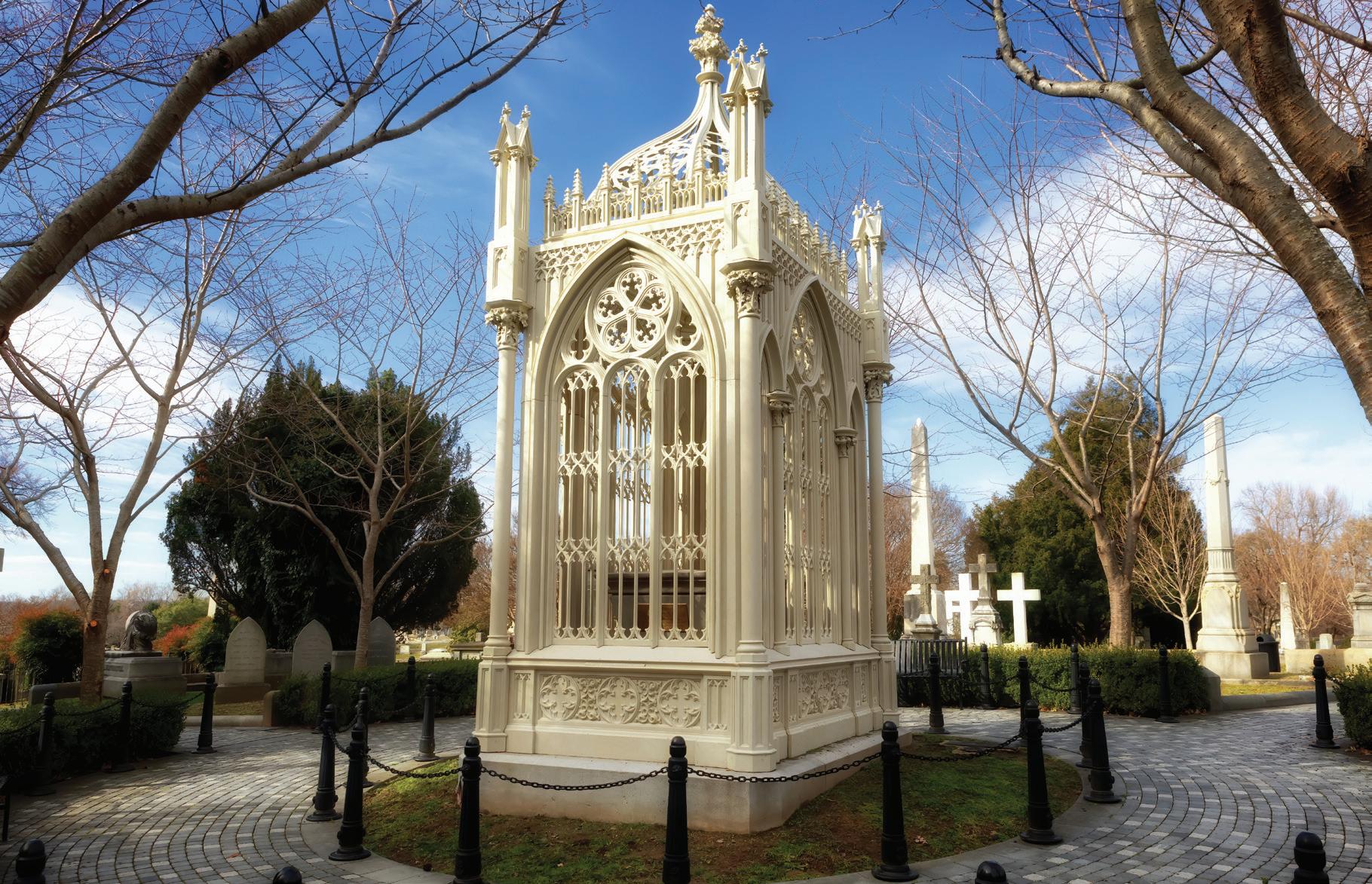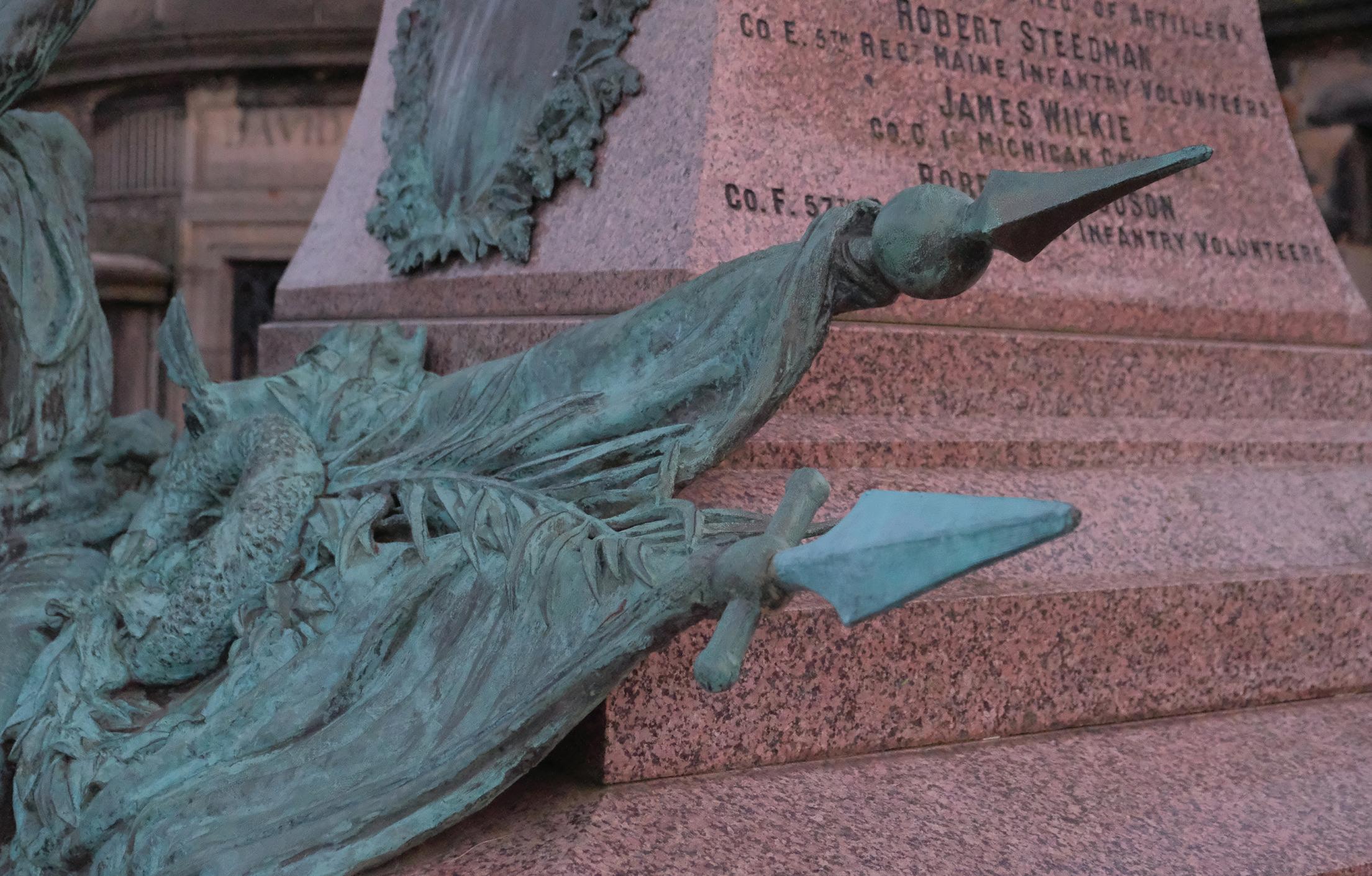Please note that the following is a digitized version of a selected article from White House History Quarterly, Issue 78, originally released in print form in 2025. Single print copies of the full issue can be purchased online at Shop.WhiteHouseHistory.org
No part of this book may be reproduced or distributed in any form or by any means, electronic or mechanical, including photocopying, recording, or by any information storage and retrieval system, without permission in writing from the publisher.
All photographs contained in this journal unless otherwise noted are copyrighted by the White House Historical Association and may not be reproduced without permission. Requests for reprint permissions should be directed to rights@whha.org. Contact books@whha.org for more information.
© 2025 White House Historical Association.
All rights reserved under international copyright conventions.

in the heart of edinburgh, atop the windswept heights of Old Calton Cemetery, stands a weathered yet resolute statue of Abraham Lincoln, the oldest statue of an American president in Europe. Erected in 1893, this bronze figure, sculpted by George Edwin Bissell, honors the Scots who fought and died for the Union during the American Civil War. Funded by the generosity of industrial titans Andrew Carnegie and John D. Rockefeller, the monument stands as a testament to the transatlantic bonds forged in the crucible of war. On an icy Christmas Day in 2021, I stood before this statue, deeply moved by its connection to an American president and the White House, thousands of miles across the Atlantic. The figure of Lincoln, flanked by a once enslaved man and a Union soldier, was worn by time, its bronze surface dulled by Scotland’s relentless wind and rain. Most striking was a spear tip missing from the soldier’s weapon at the statue’s base—a small but poignant imperfection that lingered in my mind.
Inspired by this discovery, I resolved to restore the statue and transform it into the cornerstone of a new tradition. Less than two months later, on Presidents’ Day 2022, I collaborated with the Scottish government and the City of Edinburgh to refresh the monument for a wreath-laying ceremony led by the U.S. consul general and leaders of the Scottish government and Edinburgh.
During the restoration, an astonishing find came to light: a conservation worker decades earlier had saved the missing spear tip, storing it safely. It was rediscovered, reattached, and became a powerful
STEWART D. M C LAURIN PRESIDENT WHITE HOUSE HISTORICAL ASSOCIATION reflections
The Tip of the Spear
symbol of renewal. That restored spear tip marked the Lincoln statue as the “tip of the spear” for an international program, now encompassing dozens of presidential statues worldwide at which American ambassadors lay wreaths each Presidents’ Day to honor the legacy of American presidents. The connection among Lincoln, Scotland, and this global tribute underscores the enduring resonance of presidential history across borders.
The story of this statue is but one thread in a broader tapestry of presidential legacies, woven through final resting places, historic sites, and the dedicated individuals who preserve their stories.
Closer to home, in Washington, D.C., Congressional Cemetery holds its own rich history, beautifully chronicled by Rebecca Roberts in this issue of the Quarterly. Kurt Deion, a White House Historical Association Next Gen Leader, continues to uncover the cemetery’s historic connections to the White House and its occupants. His passion for presidential history led him on an extraordinary journey across America to visit the grave site of every U.S. president, from the grand to the humble. Deion’s work illuminates the human side of these leaders, whose legacies are etched not only in policy but in the places where they rest. A half century ago, Wisconsin social studies teacher Russell Beckman was similarly inspired to visit presidential grave sites, and his journey is recorded in this issue.
Among these sacred sites, few are as magnificent to me, personally, as the final resting place of President James Monroe in Richmond, Virginia’s Hollywood Cemetery. Monroe, the fifth
above
Stewart D. McLaurin participates in a Presidents’ Day Wreath Laying ceremony at the Scottish-American Soldiers Monument in Edinburgh, Scotland, 2022.
opposite
The ScottishAmerican Soldiers Monument was erected in Old Calton Burial Ground in Edinburgh in 1893 and features a bronze statue of President Abraham Lincoln.
U.S. president, was born in Westmoreland County, Virginia, and died in New York but was reinterred in Richmond in 1858, in recognition of his deep ties to Virginia. His tomb, designed by Albert Lybrock in a Gothic Revival style, is a masterpiece of ironwork and stone, often cited as one of the most beautiful presidential resting places in America. Set against the backdrop of the James River, the tomb’s intricate latticework and soaring spire evoke a sense of dignity and permanence, befitting a man who shaped the early republic. Visiting this site, I felt the weight of history—a connection to a leader whose grave site, one of my favorites among those I’ve visited, radiates beauty and majesty.
The thread of presidential legacy extends beyond monuments and grave sites to the personal stories of those who honor them. Recently, I visited Oak Spring Garden Foundation at the Virginia estate of Paul and Rachel (“Bunny”) Mellon, a close friend of the Kennedys. There I learned of a memorial wreath designed for President John F. Kennedy’s grave site at Arlington National Cemetery, a project that was completed but never installed at the grave site. Conceived by Tiffany & Co. designer Jean Schlumberger, with sculptor Louis Feron crafting the piece and facilitated by Bunny Mellon in collaboration with Jacqueline Kennedy, the broze wreath was intended to be a living tribute, blending
Schlumberger’s signature elegance with profound symbolism. The components are in storage at the John F. Kennedy Presidential Library and Museum. This story will be featured in an upcoming episode of my White House 1600 Sessions podcast, a platform dedicated to exploring the little-known and hidden histories of the White House and the presidency.
In that episode, I have the privilege of speaking with James Felder, a remarkable man whose life intersects with one of the most poignant moments in American history. As a young Army officer in 1963, Felder was nearing the end of his tour of duty when President Kennedy was assassinated. Assigned to the honor guard, he was dispatched to Andrews Air Force Base to meet the president’s arriving casket. Felder and his team remained by Kennedy’s side through the somber journey—from the autopsy at Bethesda Naval Hospital to the White House to lying in state at the Capitol and, finally, to the burial at Arlington on November 25, 1963. His vivid recollections of being a young Black Army officer, shared with quiet reverence, capture the gravity of those days and the honor of serving a fallen leader. Felder’s story underscores the human cost of leadership and the enduring respect for those who bear its burdens.
The Lincoln statue in Edinburgh, Washington’s
This elaborate Gothic Revival cast iron cage marks the gravesite of President James Monroe in Hollywood Cemetery in Richmond, Virginia. Often called “The Birdcage,” the tomb is made of cast iron.
The tip of the spear, once missing from the weapon at the base of the Scottish-American Soldiers Monument, was restored and returned to the statue in 2022.
Congressional Cemetery, Monroe’s tomb in Richmond, and Kennedy’s unrealized wreath are more than places and relics; they are touchstones of a shared history that spans continents and generations. The Lincoln monument symbolizes the sacrifices of Scots who fought for the Union, the cause Lincoln championed. Its restored spear tip, a small but powerful detail, sparked a global tradition of honoring presidents. Monroe’s tomb, with its Gothic elegance, reflects a man whose life shaped the early republic, and remains one of my favorite presidential resting places. The Kennedy wreath, though never placed, speaks to the enduring grief and admiration for a leader cut down in his prime, preserved through the memories of figures like James Felder.
These stories converge in their celebration of legacy—how it is built, honored, and remembered. From Edinburgh’s icy hilltop to Richmond’s serene riverbanks, from Congressional Cemetery’s historic grounds to Arlington’s hallowed earth, the history of the White House itself and the lives of American presidents resonate through time. Kurt Deion’s pilgrimage to their grave sites, my own visits to
these sacred places, and learning of Schlumberger’s wreath remind us that history is not static; it is a living narrative, carried forward by those who tend its flame. The White House 1600 Sessions podcast, through stories like Felder’s, ensures that these connections endure, inviting new generations to reflect on the leaders who shaped a nation.
As I stood before Lincoln’s statue on that Christmas Day, I could not have foreseen how a missing spear tip would inspire a global tradition. Nor could I have imagined that my journey would lead to Richmond’s Hollywood Cemetery or the quiet archives of Oak Spring and the Kennedy Library. Yet these moments—linked by the shared thread of presidential legacy—reveal the power of history to connect, inspire, and endure. From the Scots who fought for the Union to the honor guard who carried Kennedy’s casket, from Monroe’s revolutionary spirit to Schlumberger’s unfulfilled tribute, these stories remind us why we honor our history and presidents: they are the architects of a nation in their time. Their lives and legacies are the tip of the spear for America’s ongoing story, soon to be 250 years old, and beyond.
right




